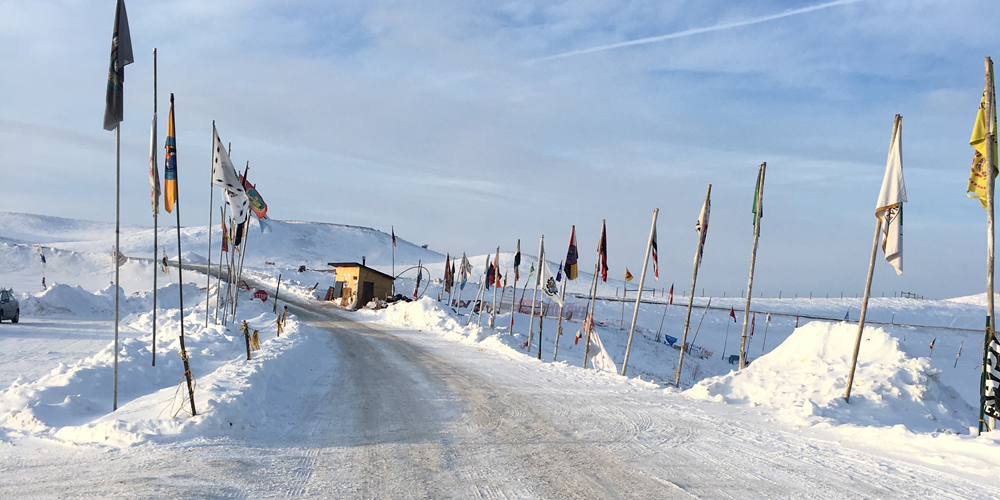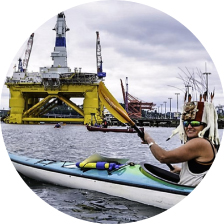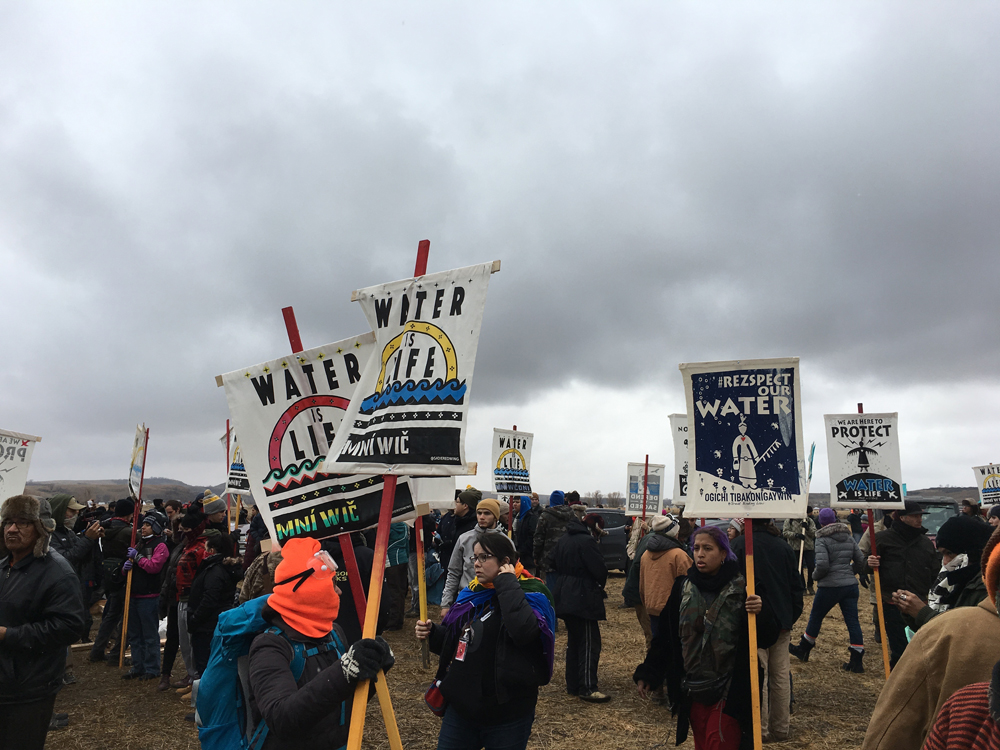
The Water Protectors of Standing Rock
A Mosaic of Voices from the Movement
by L.M. Browning • Photography by Elizabeth Hoover
Featured in the Spring 2017 Issue | Print Edition » | Visit The Wayfarer Store
Our definition of a “wayfarer” is a wanderer whose ability to re-imagine the possible
provides the compass bearings for those on their way. A wayfarer can be a writer, artist, musician,
activist, volunteer—anyone who is charting the way for change. Each issue we feature a profile
of a wayfarer and highlight what they are doing to be an agent of change in the world.
For the first time in the history of our publication, we have chosen to feature a movement as our wayfarer.
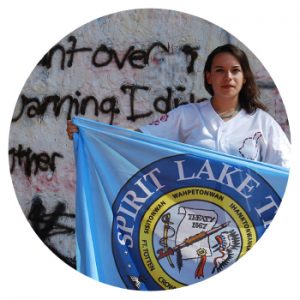
Sadie Red Wing
(Spirit Lake Nation)
Age: 26
Occupation
Graphic Designer
When were you at standing rock?
I first went to Standing Rock August 11th, 2016. I have made over 15 trips to the camps in Standing Rock.
My latest trip ended on December 8th, 2016.
What made you go to Standing Rock?
On August 10th, 2016, there was a call to action for people to head to Cannon Ball, North Dakota to block the entry points of the Dakota Access Pipeline equipment. Without a question, I headed up to Cannon Ball with donations and participated in the prayers along Highway 1806. The motivation of me going to Cannon Ball came from my heart and home. My family and I live along the Missouri River. Any tampering to the water effects my home. I felt it was my duty to join the fight in protecting water for the sake of my families’ lives, my life, and the future generation’s life. Water is important to me and my culture—I would feel guilty NOT protecting our water.
What was your impression of what’s taking place on the ground?
In the earlier times of action, my first impressions were very mixed. I was determined to be on site, but I was also shocked to see what the Dakota Access Pipeline construction was doing to our lands. It was a beautiful feeling to be around prayer along Highway 1806. I was impressed that majority of the action was being done by my generation (20-30 of age). My personal friends did a great job leading women and children to safe areas and conducting prayer. I could not be any happier to be involved in the situation, but I also was very upset of the forceful confrontation brought onto the protectors. Nobody likes to see their peers harmed in anyway. I know I did not like seeing my friends beat, bloodied, maced, and jailed by the DAPL security just for standing in prayer. It was an extremely emotional time.
What is the mindset of the protectors?
I cannot speak for all water protectors, but I believe the mindset of those fighting against the pipeline is protection. We want clean water for our future generations. We want our treaties honored. We are fighting to protect ourselves as Native Americans. The fight against the pipeline has been a great time to revive cultural traditions that have not been practiced frequently in the past—I found that very beautiful. On the downside, the fight has shown how subordinate we (Native Americans) are in the world. It has shown how lifeless we are in the media, how little our human rights are taken into consideration, and how our culture is still mocked by others who do not care to understand our way of life.
What is a positive memory you will keep from within the chaos of the experience?
I have multiple positive memories from the experience. I think what makes me smile the most is the brothership shown amongst my peers at camp. I enjoyed sitting in a tipi, or around a fire, listening to stories that made us all laugh. During the days of celebration, people in the camps commemorated in their traditional ways. It was amazing to hear on one side of camp playing hand games, while the other side of camp was singing round dance and ceremonial songs. People war hooped and trilled until the early hours in the morning under the bright stars. The positive energy was something I’ll never forget. I even developed a closer relationship with a friend I met a few years back. All these memories make me want to continue to go back to Standing Rock.
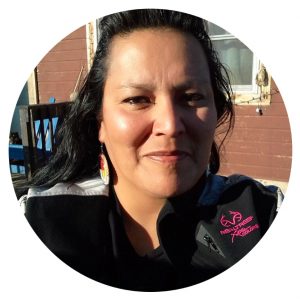
Glenna (Eagle) Yellow Fat
(I am a Hunkapa Lakota from Standing Rock.
I was born and raised in Fort Yates North Dakota.)
Age: I hit my 42nd summer July 2016.
Occupation
I am the wife of Standing Rock Tribal Councilman
Dana Yellow Fat. Together we have 6 children,
3 daughters and 3 sons. We, as a family, have been fighting against the Dakota Access Pipe Line since before
the movement went nationwide.
When were you at Standing Rock?
On April 1, 2016 a prayer ride took place. The ride started in front of the Standing Rock Tribal Administration building in Fort Yates and ended in Cannonball, nd. That day was when Sacred Stone Camp was started. There were less than 75 people that took part in that ride. Even fewer that set up a tent or tipi at the first camp. We continued to try to get the word out there about this pipeline and what would happen. While there was a Bismarck news station that documented the movement that day. It was like no one really paid attention. I am proud to say my husband and 3 of our children participated, 1 of our sons led the ride for the first 15 miles, carrying the family eagle feather staff.
What made you go to Standing Rock?
The proposed crossing is right in our backyard. We became more aware of it after my husband was voted onto the council in October 2015. That is when I first started posting on Facebook against DAPL.
What was your impression of what’s
taking place on the ground?
I am amazed by how big this ‘movement’ has grown since we did the ride. Beyond thankful for those that answered to call for help and pushed this national. Back in August when this first blew up and we got the call that we were needed at the frontline, none of us knew what to expect. We were running around gathering things that we might need out there. We knew there were police, but we didn’t know how they were going treat everyone. So, one of the main things we grabbed were scarves to cover our noses and mouths, who has respirators or masks on hand on a daily basis if you don’t need them? We were already worried back then about them using tear gas and mace against us. Thankfully that didn’t take place back then. Our 3 oldest children were going to go with us and they were kind of freaking out because they immediately thought back to the fight against the kxl Pipeline. They knew how things got back then by watching news and posts from friends that were there. To say they were scared is an understatement. We started posting on Facebook for people to meet us out there. There wasn’t much we could say as we weren’t given much information ourselves.
What is the mindset of the protectors?
Since then so much has taken place, thousands have physically shown up to show support, and things have escalated numerous times. One thing the Pro-dapl people can’t seem to understand: This isn’t just about us, Standing Rock, it’s about the millions that depend on this body of water for life. This isn’t about any one race, it’s about the Human Race and its future. That is why we are all fighting so hard against this. I want my children and grandchildren to have a future. When the pipeline breaks, there goes the future of agriculture, wild game, fish, all fauna, cattle, etc… How are we supposed to continue to live without all of that? And that is why, we will continue to fight against the corporations and government if that is what we have to do.
What is a positive memory you will keep from within the chaos of the experience?
One of the biggest positives of this whole movement has been the coming together of all the Native Nations. Historical enemies have gathered under One Purpose to fight against a common enemy! In addition to that the Seven Council Fires was convened, that hasn’t been done since 1876! To be able to bear witness to that is indescribable. To be a part of history in the making every single day has been amazing. All the indigenous nations that have banded together has brought about so many feelings I have no words to describe them.
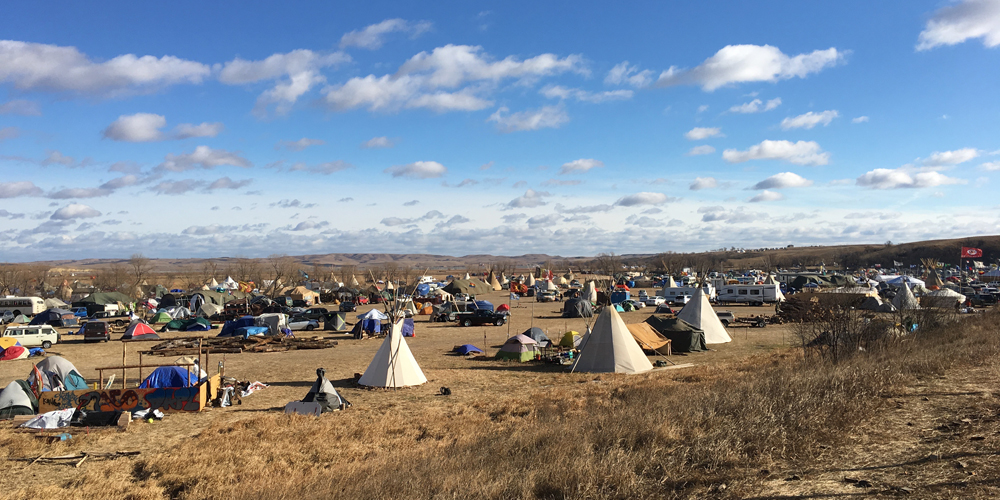
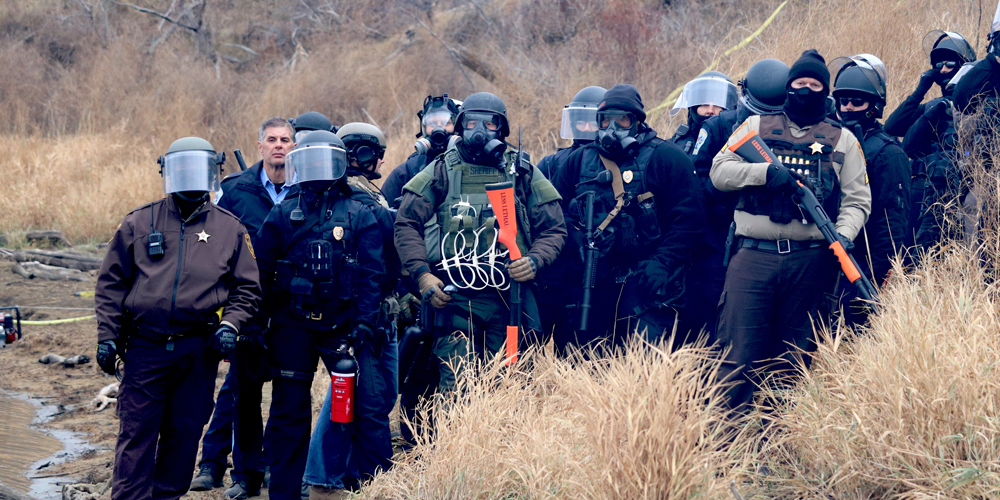
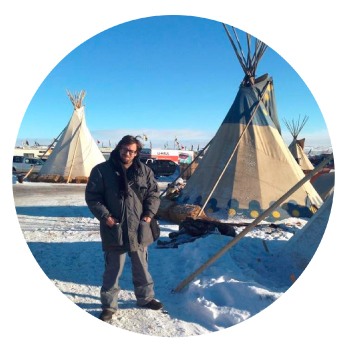
Iñaki Estívaliz
Age: 42
Occupation
Independent journalist
When were you at Standing Rock?
December 3 – 18, 2016
What made you go to Standing Rock?
The main reason to go to Standing Rock was that I realized that the information being disseminated about what was going on there was in English. I decided to travel there with the mission to report in Spanish. My reports have been published in magazines and newspapers of Puerto Rico and Nicaragua, and in the main alternative news website in Spanish: rebelion.org.
What was your impression of what’s taking place on the ground?
Immediately I realized that this is much more than a simple protest against a pipeline. On the one hand, it involves the awakening of the indigenous tribes of the continent, who for the first time in hundreds of years have been empowered to peacefully face a system, capitalist, centralized in Washington, that has massacred, exploited, marginalized and ignored them. On the other hand, it is the universal claim that we can stop depending on the fossil energies that the planet needs for its survival that humans change towards clean energies.
What is the mindset of the protectors?
They are water protectors and not “protesters.” Because water is life, and dependence on oil endangers life on the planet. Another thing that caught my attention is the conviction of water protectors in the power of prayer, which, with mutual help and solidarity, are their only weapons.
What positive memory you will keep from within the chaos of the experience?
My experience on the ground was not at all traumatic. The greatest difficulty was working under extreme temperatures in uncomfortable conditions. There was also the constant threat that the authorities could re-assault those who were there, physically or with arrest and prosecution. But far from being a traumatic experience, it was one of the most enriching experiences of my life. The realization of the solidarity of human beings in adverse situations, knowing indigenous traditions, sharing and collaborating with strangers in extreme conditions, has been wonderful. Best of all, check that a better world is possible.
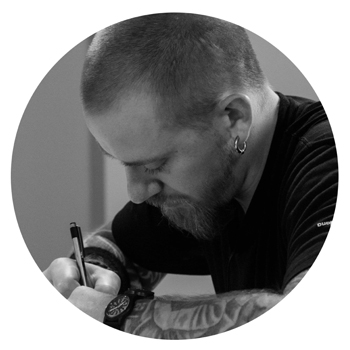
Eli Wright
Age: 35
Occupation
Retired US Army Medic, Artist
When were you at Standing Rock?
I was there from Nov. 23, 2016 to Dec. 8, 2016
What made you go to Standing Rock?:
I “deployed” to Standing Rock with a contingent of Iraq Veterans Against The War. As a former combat medic, I wanted to answer the call in support of the water protectors struggle when I saw the videos surface online of dogs attacking unarmed people. They asked for more medics, and I wanted to offer my skills to provide aid for people who were being injured at the hands of the heavily militarized police who were targeting water protectors with chemical agents, rubber bullets, and water cannons in sub-freezing temperatures. As an organization, IVAW has been working to organize resistance and educate people about the military industrial complex and its role in the militarization of domestic law enforcement. I’ve seen the war come home in many ways, and was deeply disturbed to witness how the police have become equipped with military grade weapons back home in our own communities.
What was your impression of what’s taking place on the ground?:
It was inspiring to see the massive response organized around this struggle. Standing Rock has become an important historical event not just because of the Dakota Access Pipeline, but also because of the unprecedented gathering of 300+ indigenous nations and the solidarity between native peoples and non-natives alike. While I was there, up to 4000 veterans also arrived to support the movement, just before the Army Corps of Engineers announced the denial of the easement under the Missouri River/Lake Oahe. It was at least a temporary victory in the fight against dapl, and I think it was a testament to the efficacy of grassroots organizing and the power of nonviolent direct action.
What is the mindset of protectors?
What I witnessed was a deep dedication to indigenous culture among the entire community, among both native and non-native people. There was a strong commitment to approaching every action through prayer, ceremony, and nonviolence. I cannot claim to answer on behalf of “the mindset of the water protectors” because the struggle at Standing Rock is composed of an extremely diverse range of people. Every individual heeded a call to go there for many different reasons, but what matters most is that nearly everyone is committed to a common principle of stopping the pipeline while remaining peaceful despite the violence being committed upon them and their ancestral lands. Within that framework, there remains a consistent and committed effort towards decolonization. Indigenous people from all over the world are reclaiming their identity and culture, and Standing Rock seems to be a proving ground for how they are putting those efforts into action in a very effective and historically significant way.
What is a positive memory you will keep from within the chaos of the experience?
As an Iraq veteran, I finally felt a sense of pride in service to my country and its people that I never felt while serving in the military. The camaraderie and solidarity were so present, and it gave me a sense of what all of our communities could look like when we self-organize around shared principles like that. Witnessing this indigenous-led struggle was a profoundly transformative experience. As a non-native person, Standing Rock gave me a chance to see our shared history through a completely new lens. This fight has been going on for generations, and it’s certainly not over yet.
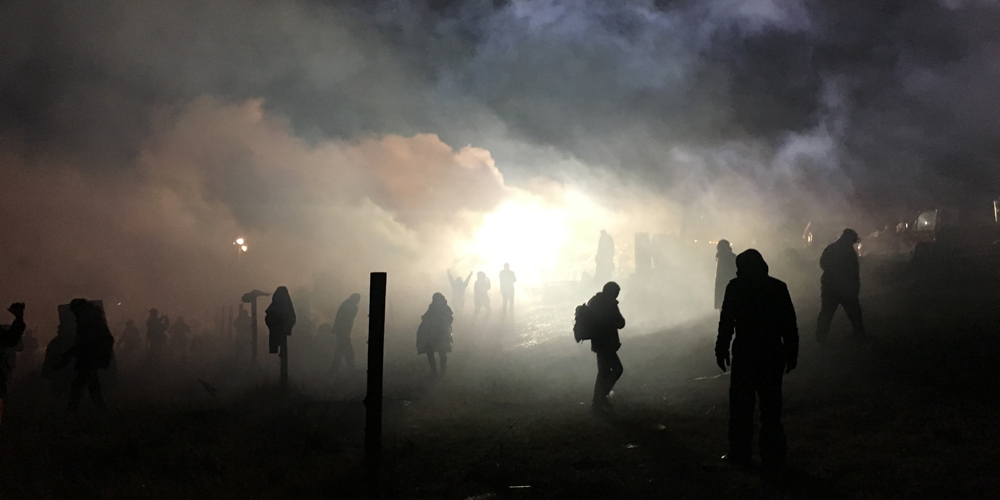
Irene Skyriver
Age
I celebrated my 62nd birthday at Standing Rock.
Occupation
I am a farmer and an organizer for Passage Rites for teens.
When were you at standing rock?
I was gone for nine days, returning on September 29th.
What made you go to Standing Rock?
I wrote this poem en route to Standing Rock. It best tells my reason for going:
Standoff at Standing Rock
Heading down the powwow highway
The Indian Nations are gathering
Their drums pound in resolute harmony
I ride a battered bus through the night
On worn-out seats I curl up fetal
And try to sleep
Eyes shut I toss and imagine
I’m in a trundling boxcar packed with others
On our way to smoking ovens
Or am I chained in the hold of a ship
Pitching in seawaters I would never have dreamed
to sail across?
The displaced. The dammed.
Moved, traded, slaughtered like cattle
The American Indian too
Herded, corralled, culled
But their trail of tears may be evaporating
Transforming into thunderous clouds
And thundering drums
I follow their call to action
Knowing a great transformation
A rebirth of power and pride
Is blooming across a bruised and battered land
Through the voice of a bruised and battered people
Indigenous wisdom re-found, re-affirmed, re-formed
Here at Standing Rock
There in the Lummi lands
And where the dams came down on the Elwa River
Unification of First Nations
In the truly sacred struggle to keep our waters wild and clean
I say A-HO! To them wherever they stand, dance, sing or pray
I’m on my way to join
The only holy battle worth the fight
For our EARTH MOTHER!
What was your impression of what’s
taking place on the ground?
I cried often while at Standing Rock. A grandparent on either side of my family was of half NW Coastal ancestry. I have always related strongly to those origins. Every person I shook hands with, was a native brother or sister, at last being seen and acknowledged.
What is the mindset of the protectors?
Pride and dignity beamed from the Water Protectors. They knew they were on the right side of history with this struggle; no longer invisible, tucked away nicely on reservations. Pouring in from far-flung places worldwide, Indigenous Peoples kept arriving; all cried with tears of joy at having found solidarity and sanity among a people fighting the same age-old struggle for the right to live in balance with the natural world. I as well!
What is a positive memory you will keep from within the chaos of the experience?
I stood upon the “Black Snake”, with others, fists raised while drums beat and prayers flew in the four directions and a “wall” of willows were planted in front of the pipeline. Empowered by my Water Protector activism, I’ve returned to my community, energized to stand up to threatening issues here: Navy Growler jets training over our homes with ear-splitting decibels, increased coal and oil tankers coming through our Salish Sea and Arctic oil-drilling. Meanwhile, I continue to hold ceremony with drum and song to carry prayers and keep my heart in health and love through it all.
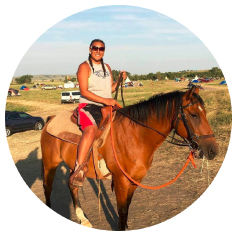
LaToya Crazy Bull
Age: 25
Occupation
College Student, substitute teacher at
The Head Start program.
When were you at standing rock?
August 15th, 2016- Present
What made you go to Standing Rock?:
I answered the call put out by the elders to come to
Standing Rock to help protect the Mni Wiconi.
What was your impression of what’s taking place on the ground?
When I first arrived in Standing Rock my impression was that this pipeline needs to stop. DAPL was working at a very fast pace, digging up burial sites, not respecting the prayers or the elders. That made me very sad to see, but I also knew there was a lot of us willing to put our lives on the line to protect the water and the earth.
What is the mindset of the Protectors?
I can only speak for myself on this question, but My mindset is that I am willing to put my life on the line to protect our Unci Maka (Mother Earth) and our Mni Wiconi.
What is a positive memory you will keep from within the chaos of the experience?
The positive memory I will keep with me is how all walks of life from every corner of the world came to stand with us. Within all the chaos, no matter if we were maced, shot, or had tear gas thrown at us, people that didn’t even know each other stepped in to take care of one another. Everyone helped each other out and many of us made lasting friendships out there on the frontlines. I am forever grateful.
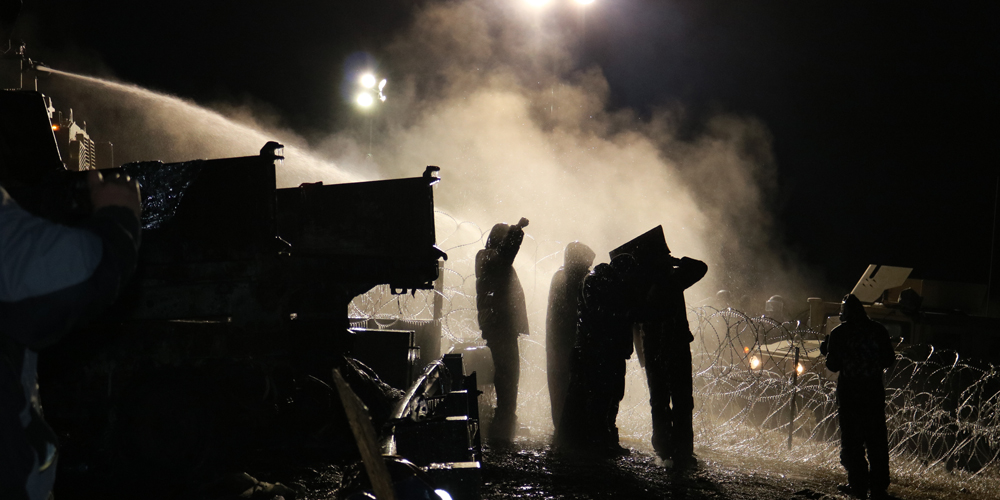
Cole Howard
Age: 32
Occupation
Freelance photographer/videographer.
When were you at Standing Rock?
December 1 – 8, 2016
What made you go to Standing Rock?
Being a documentarian, I had an urge to better understand what was actually occurring on the grounds at Standing Rock as well as to witness the movement with my own eyes. The mass media took a slow route to paying attention to the native struggle against DAPL. After the issue became more prominent on social media and the news I began to understand that the movement was an extremely important moment in human history. It was a David and Goliath story, a united stand of a historically exploited community against one of the most powerful entities in the world—Oil and Gas Corporations—and the struggle still seemed to be underrepresented in the news. I did not decide to actually go to Standing Rock, however until I had received an invitation to travel alongside a group of veterans. Before that I feared being underprepared to navigate the weather and that I could be a nuisance on the community. Once I received the invitation, I immediately began to pack.
What was your impression of what’s taking place on the ground?
Standing Rock was kind of overwhelming to initially integrate into. It is like a small city of differing groups of people aligned with the same goal—to protect the water and defeat dapl—yet the different groups definitely had different ideas on how to accomplish those goals. The community was beautiful. The differing attempts to unify the camp were beyond impressive like the mandatory orientation that all new campers were required to attend, which taught the populace how to be of aid to the community and respectful to the native customs, or the activism trainings that taught water protectors how to peacefully protest with organized resistance. But despite all of that there was an undertone of political dissonance between some of the groups, and understandably so. As one water protector once told me, “Decolonization of this magnitude has never really been attempted. Of course many of us are still figuring out the road map to it!”
What is the mindset of the protectors?
Overall the mindset of the water protectors was generally positive and filled with hope. There were definitely some that were filled with worry and stress was a very common theme amongst a majority of the water protectors that I saw, but despite the worries, there always seemed to be a back context of genuine hope.
What is a positive memory you will keep from within the chaos of the experience?
It’s funny how the simple things are sometimes the most meaningful. I remember multiple sunsets that stood out and one very starry night where I stood outside with a group of the vets and chatted about our lives. But the one positive experience that really stands out is when I volunteered in a community kitchen. Because I was there to document the experience, I did not get a lot of time to participate in camp life, however, one night when I was stressed out and hungry, one of the vets who I was camping with offered to have me join him at a community kitchen to volunteer and then eat. I was resistant because I wanted to focus on my work, but I knew I needed to eat and was tired of eating MREs (military instant food) and I agreed to accompany him.
As soon as I began working in the kitchen, helping melt snow for dishwater, washing dishes, helping move around flats of food, etc. all of my worries disappeared and I truly felt like I was partaking in the community experience. It was simple moment refuge from the bitter cold weather and the fear of a police raid; it was a moment to help out with a smile and eat with friendly faces. Although this moment probably seems inconsequential in the scheme of things, it felt warming to my heart.

Kai Sanburn
Age: 62
Occupation
Nurse at a remote rural clinic.
When were you at Standing Rock?
September 21-26, 2016 & November 1-13, 2016
What made you go to Standing Rock?
Of all the calls to action, all the slogans of the various efforts to protect and defend our air, water, and our children’s future, “Water is Life” struck me with its clarity. It’s a simple statement that defies argument and challenges polarization. For me, it conjured pure water in a glass, faith in the waters of a rushing river, the clarity of a pristine lake and our utter dependence on all of these. I began to pay attention to the growing resistance to the pipeline in North Dakota through the summer but, as a white woman, was unsure about my place in the standoff initiated by the Standing Rock Sioux and joined by a historic gathering of tribes. Over time, it became clear that this was a message and a fight that I wanted to add my voice and support to, so when the call came for allies, I got on a Greyhound bus and headed east.
What was your impression of what’s taking place on the ground?
There were more people in camp, fewer elders around the fire, more non-natives and it was getting cold. Morning in the still dark, a voice would call out, “Good Morning, Relatives! It’s time to get up. Mni Wiconi! Water is Life! Brothers, sisters, find your coffee. Come pray for Mother Earth. Hurry, the sun is coming to greet you!” Soon, drumming and sung prayer would wash over the camp as the sun rose across pink and frosted hills. The magic remained but unity of purpose bumped into differing opinions about tactics. Ceremony and prayer were and are the guiding principles but interpretations of what resistance means in practice created division in the warrior communities. As one young warrior said to me, “I’m here to kill the black snake. You don’t do that by falling back each time you’re told to.”
What is the mindset of the protectors?
I was there in the aftermath of several traumatic actions, had friends up close, pepper-sprayed, arrested and charged with felonies. A traveling partner worked in the mental wellness tipi, where a steady stream of people sought help to defuse the anxiety and trauma left by what the police unleashed. There is no discounting the impact of the militarized response by the police and the state. As I stood in a line, facing off heavily armored and faceless cops, the last illusions I had about police in our country fell away. There they stood, protecting the big earth-eating machinery of DAPL, defending it against the water protectors, unarmed men and women, some camo-clad, others in bright skirts, holding nothing more than bright banners and raised fists. I witnessed the cops target a young man, Native American as was the pattern, shove him to the ground and bend him backward, the weight of all 4 of them grinding his face into the dirt. As I watched, they ordered me to move away, batons and guns waving about. I backed away but later, I wished I’d held my ground, wondered what it would have taken to stand against their order to abandon that young man to their aggression. Post-election, this seems an even more relevant question to explore.
What is a positive memory you will keep from within the chaos of the experience?
Whether on the volatile front lines or in a support role around the camp, most of the people I met were changed by Standing Rock. They reference a profound sense of welcome, the beauty and power of prayer, a feeling of kinship and being part of something much bigger than the pipeline fight itself. For those that stepped up and pitched in, there was an uncommon sense of community, first with all its bright hopes and in time, with all the flaws and worthy challenges that come when diverse people live together.
Standing Rock may well stop this pipeline, (reports of financial woes circulate these days), but the real success of this historic encampment will be the sowing of its seeds far and wide. It will show up at front lines everywhere, will be there in advocacy for the rights of indigenous people. It will, perhaps, guide a shift in our relationship to Mother Earth, to our water, and to each other.
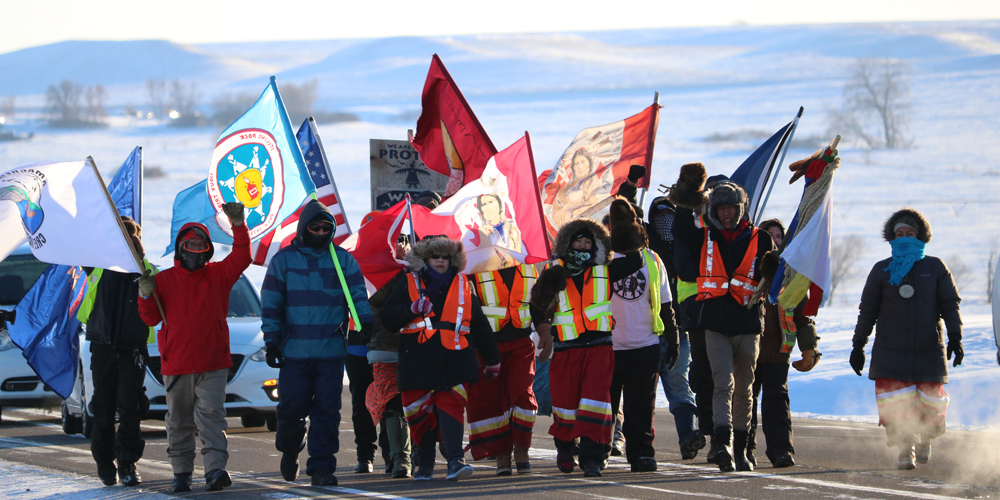
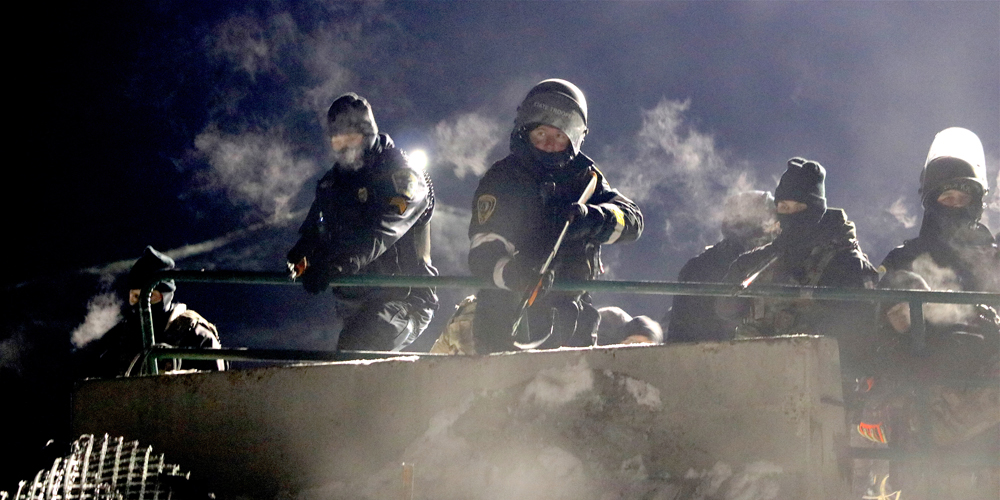
Closing Note
I gathered the profiles of the protectors in the early winter of 2016. Since then, many changes have taken place . . . . On December 4, 2016, I was at Lyric Hall—a historic theater in New Haven, Connecticut—helping at a benefit to raise money for the Water Protectors at Standing Rock. The room was buzzing. Bands were playing, artisans were selling their goods to raise money, people were manning the phones calling the White House, our Representatives—anyone and everyone—and I was tucked away capturing it all with a pen and a pad. It was the very evening President Obama ordered that the pipeline be halted. I remember someone grabbing the mike during the concert to read aloud President Obama’s statement. A ruckus of joy erupted in the hall as an even louder victory cry echoed out from the Standing Rock Camps.
As we all know, the victory was short-lived. On January 24th, after just 4 days in office, Donald Trump issued two executive orders to further the construction of the Dakota Pipeline as well as the Keystone Pipeline. (It should be noted, both Trump and his Secretary of Energy, Rick Perry, have a monetary stake in the construction of 3.8 billion dollar project.) On February 2nd, the camps at Standing Rock were raided and some 70+ people were arrested (bringing the total arrests since August 2016 to an estimated 625.)
After these events, some asked me what the point was to still going ahead with this profile, (given that things have changed so much since December). My response was to explain that it was never about writing a piece that chronicled every shift in policy. The decision to make the Water Protectors our “wayfarer” of the issue, was made with the intention of gathering a mosaic of profiles to tell the stories of those on the ground because, no matter what happens—whether the pipeline is built or not—these people, their stories, and their actions will endure. No executive order can suppress what sparked on those grounds in North Dakota.
At the moment, the future of the pipeline is in question. While Trump issued his executive order, it is now in the hands of the Acting Secretary of the Army to approve the pipeline proposal and allow the developers (Sunoco Logistics, Energy Transfer Partners, and Energy Transfer Equity) to complete the line. Such approval is probably a forgone conclusion; nevertheless, the movement that was sparked cannot be plowed over. Ideas, truth, conviction—these things are immortal and beyond the reach of even the most powerful of tyrants. Some Protectors are disheartened by the impending construction, and rightfully so; however, as Glenna “Eagle” Yellow Fat reflected, the battle for Standing Rock goes beyond this action.
It is a battle for all water—for the land and for life—on behalf of humanity, both present and future generations.
The fight of the water protectors is still going and will continue. Even if you can’t come to the camps, you too can become a Protector by taking action to defend the earth’s watersheds from corporate threats. Call your representatives—be vocal; divest from banks that support corporate polluters, and use your talents in the fight! Everyone is needed . . . everyone has a place in the battles that lie ahead.
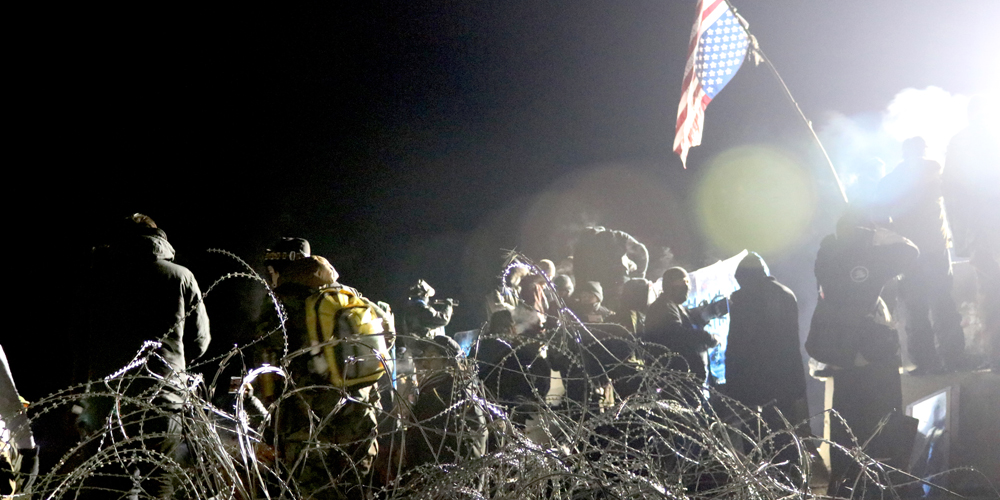
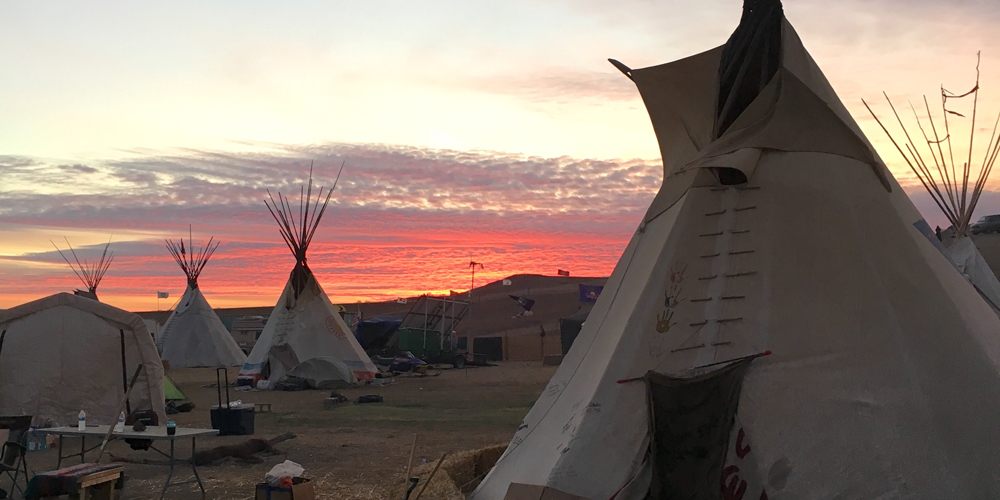
L.M. Browning is the author of nine books. In 2010, she debuted with a three-title contemplative poetry series. These three books went on to garner several accolades including a total of three pushcart-prize nominations, the Nautilus Gold Medal for Poetry and Forward Reviews’ Book of the Year Award. Balancing her passion for writing with her love of learning, Browning sits on the Board of Directors for the Independent Book Publishers’ Association, she is a graduate of the University of London, and a Fellow with the International League of Conservation Writers. She is partner at Hiraeth Press as well as Founder and Editor-in-Chief of The Wayfarer. She is currently working to complete a degree at Harvard University’s Extension School in Cambridge, Massachusetts. Visithttp://lmbrowning.com lmbrowning.com
Elizabeth Hoover is Manning Assistant Professor of American Studies at Brown University where she teaches courses on environmental health and justice in Native communities, Indigenous food movements, and community engaged research. Elizabeth is also a member of the leadership committees of the Native American Food Sovereignty Alliance (NAFSA), and the newly formed Slow Food Turtle Island regional association, and is a board member of the Environmental Justice League of RI (EJLRI). Elizabeth has published about environmental reproductive justice in Native American communities, the cultural impact of fish advisories on Native communities, tribal citizen science, food sovereignty, and health social movements. You can learn more about her work at gardenwarriorsgoodseeds.com. She traveled to Standing Rock on November 17-28, 2016 and January 9-19, 2017 to cook, hear stories, and provide support for water protectors.
To bring each issue of The Wayfarer to fruition, it takes hundreds of hours each season to craft, edit, design, and distribute the journal. If you find joy and enrichment within our features, please consider becoming a supporter with a small donation. There is no set amount. Whether it is .99 or a few dollars, we appreciate any gift you care to give. While at this time we are not a non-profit all donations do go towards ensuring the future of the journal.
